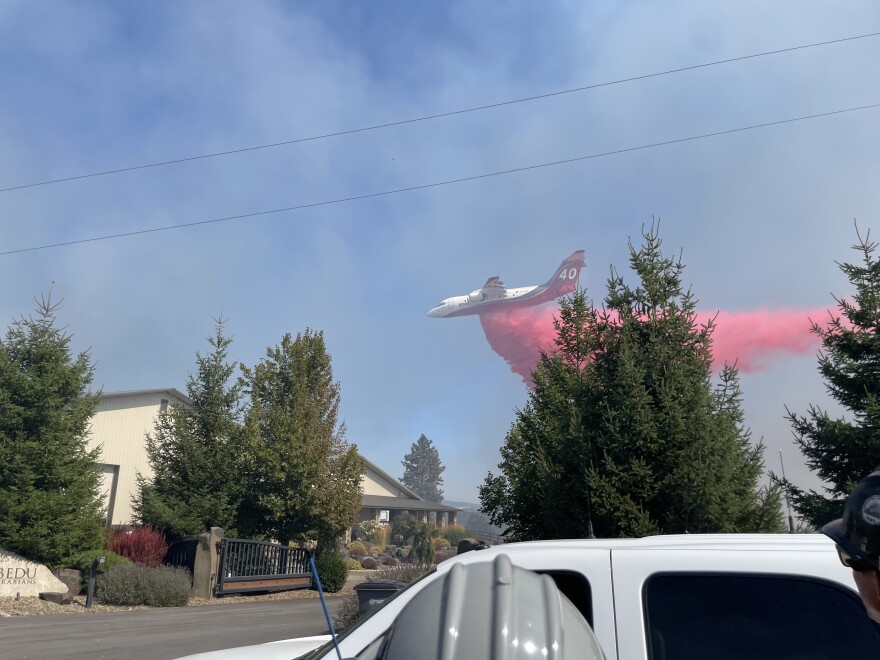Listen
(Runtime 1:55)
Read
The use of aerial fire retardant to fight wildfires could be further restricted to protect the environment.
A handful of groups from western states filed a motion last week to intervene in a lawsuit brought by an Oregon environmental group against the U.S. Forest Service for inadvertently dumping fire retardant into streams.
Jason Sparado is the executive director of the Washington Forest Protection Association, which represents private forest landowners in Washington state. The association is one of the organizations that filed a motion to intervene in the case. He said he and the other organizations want to make sure firefighters don’t lose the ability to use aerial retardants.
“We want the court to know that there's human lives at risk, there are homes and towns and lands, forest lands, all at risk, and every tool in the toolbox is needed to prevent devastation from wildfire,” Sparado said.
The Forest Service Employees for Environmental Ethics (FSEEE) brought the lawsuit against the USFS.
Andy Stahl, the executive director of FSEEE in Oregon, said fire retardant, which is composed primarily of ammonium phosphate, a common chemical in fertilizer, is damaging to the environment, particularly to fish and water. While Stahl said the Forest Service Employees for Environmental Ethics would like to see the USFS stop using aerial fire retardant altogether, he said the group primarily seeks better water protection.
The USFS has a 300-foot buffer around national forests’ streams and rivers where they cannot apply the chemical. But inadvertent dumping has occurred, so Stahl said his organization is fighting to have the application buffer area increased to 600 feet.
The USFS previously agreed to a 600-foot buffer to protect an endangered frog species that lives in Oregon and California, Stahl said.
“We're just saying to the judge, ‘Well, if it's good enough for the frog, then it’s good enough for the fish too,’” Stahl said. “Let's just stay 600 feet away from the water.”
Stahl said, beyond the environmental consequences, fire retardant is not effective at dousing flames.
Susan Prichard, a research scientist at the University of Washington studying fire ecology, landscape vegetation, fire dynamics and fire and fuels management, said aerial fire retardant is generally ineffective on fires in dense forests, because it does not reach the ground.
Jay Wilkins, a division chief with the Spokane County Fire District 8 and a member of the Washington State Council of Firefighters Wildland Committee, said that applying the retardant to denser forests is less effective at reaching the fire on the ground. But, he said experienced command teams should decide how best to use the tool. He said aerial crews are there to knock out heat and suppress fuels to help ground crews get ahead of the flames and extinguish the fire.
Furthermore, firefighters say the retardant is part of the toolbox and effective and useful when applied properly.
“A lot of the aerial firefighting that you see ... basically gives ground crews a fighting chance,” Wilkins said.
Spadaro, a forester for over 30 years, said he’s seen retardant work as an effective strategy.
In response to the litigation, the USFS has agreed to file for Clean Water Act permits to authorize the use of aerial fire retardant, according to the U.S. Department of Justice, which represents the USFS.
According to the summary judgment, “Consequently, the Forest Service anticipates that it will have to discharge fire retardant to waters in limited circumstances until 2025 without a permit. However, these potential future Clean Water Act violations do not themselves provide a basis for the finding of liability or the broad injunctive relief FSEEE seeks.”
The Forest Service Employees for Environmental Ethics stated USFS is operating unlawfully without those permits. The permit process could take over two years to complete.
The U.S. Forest Service could not comment due to ongoing litigation.

